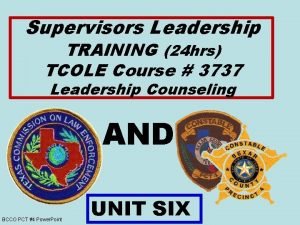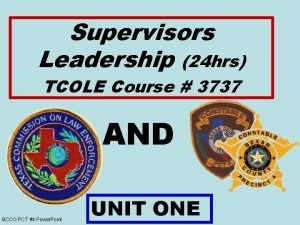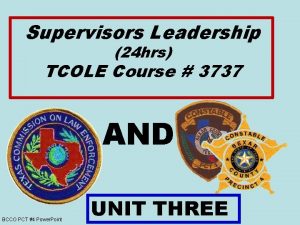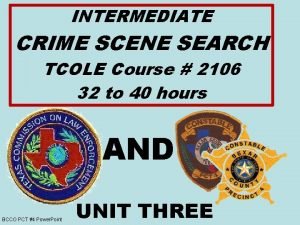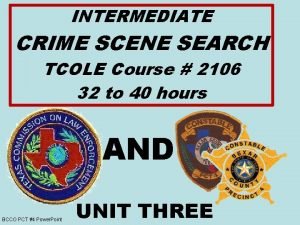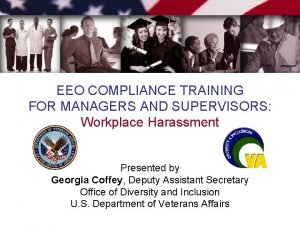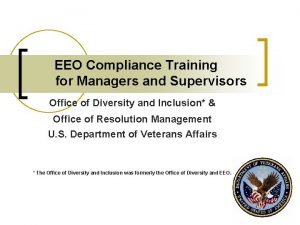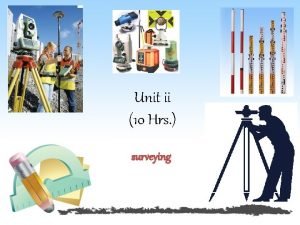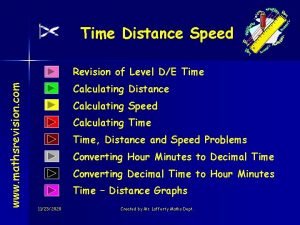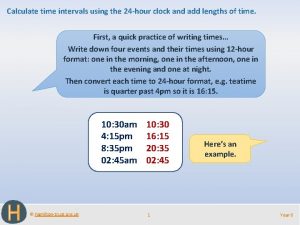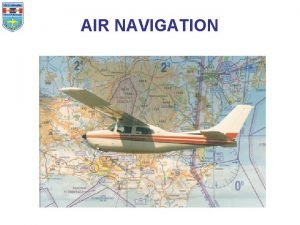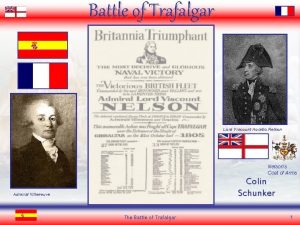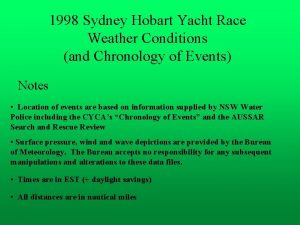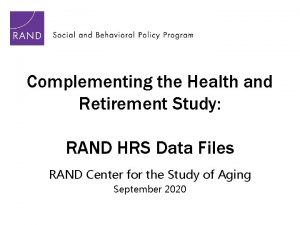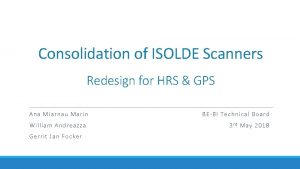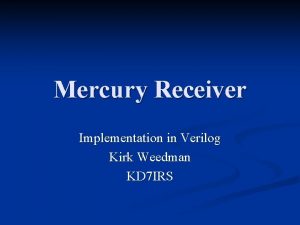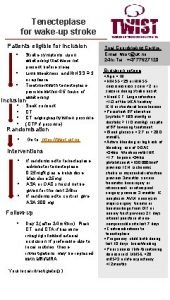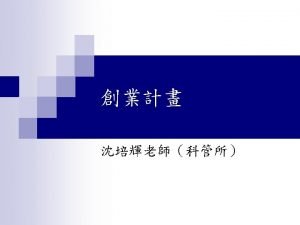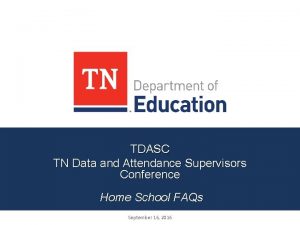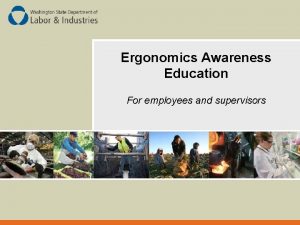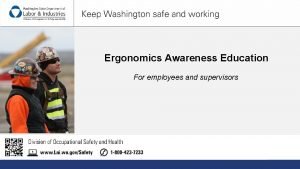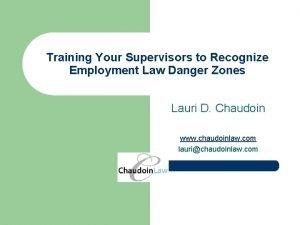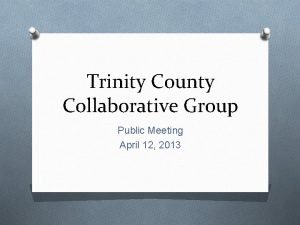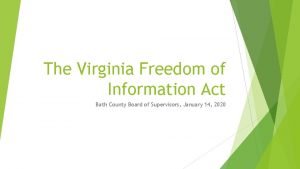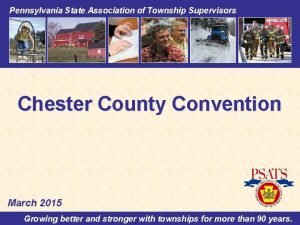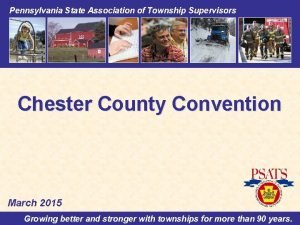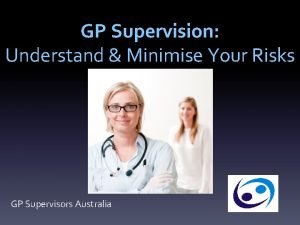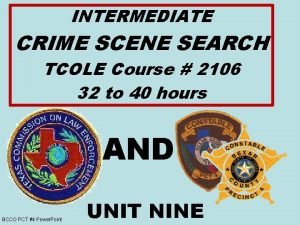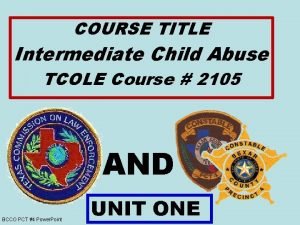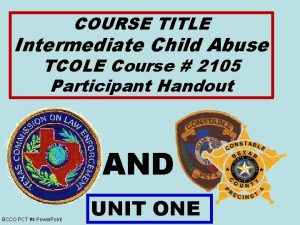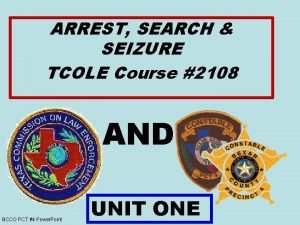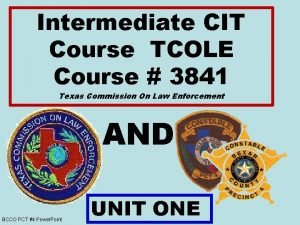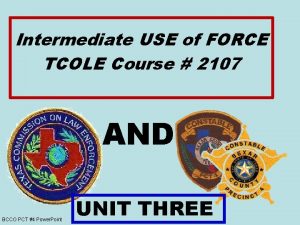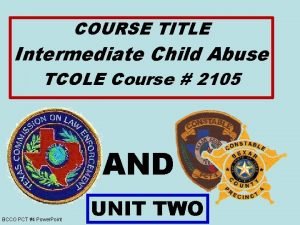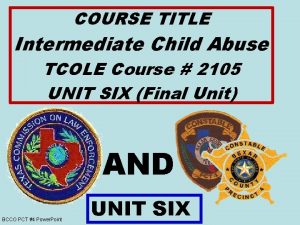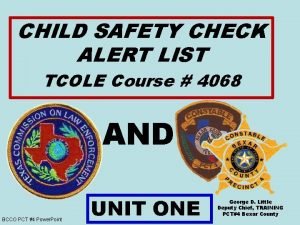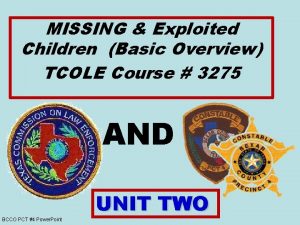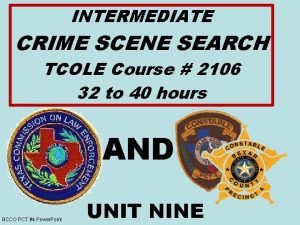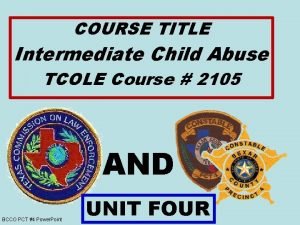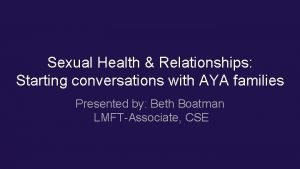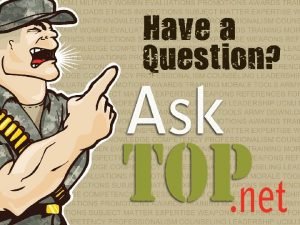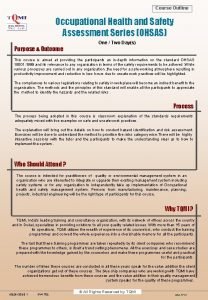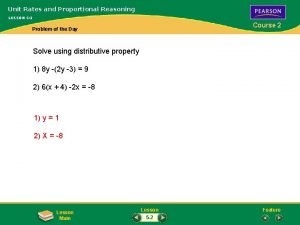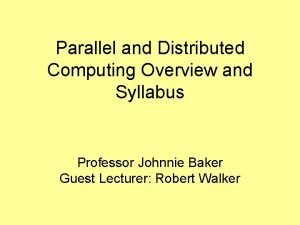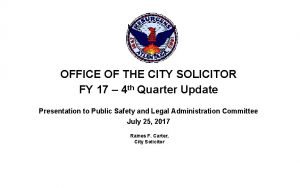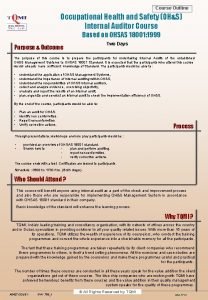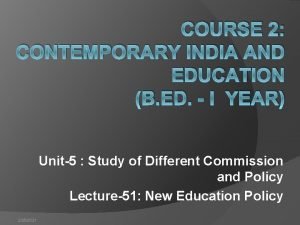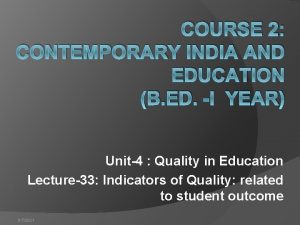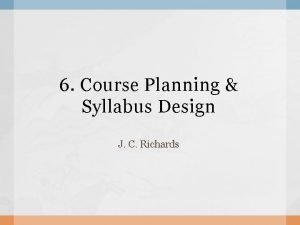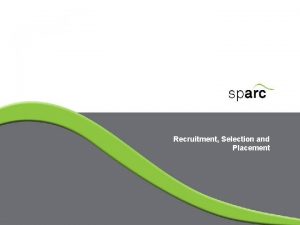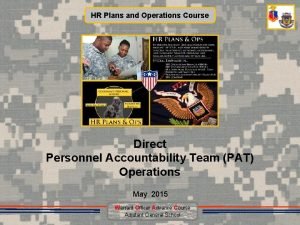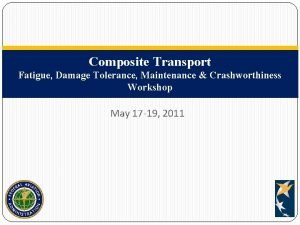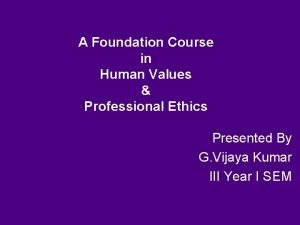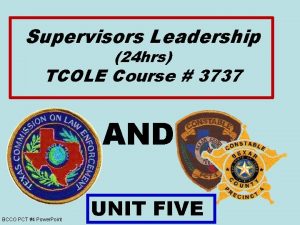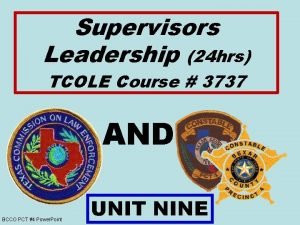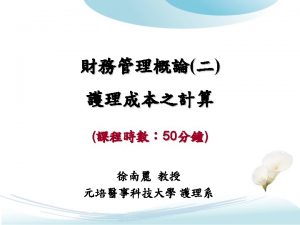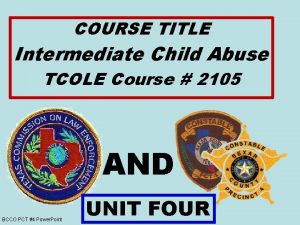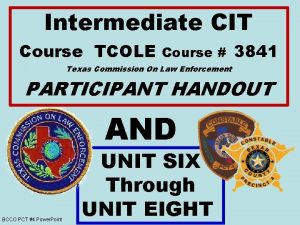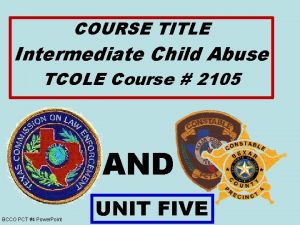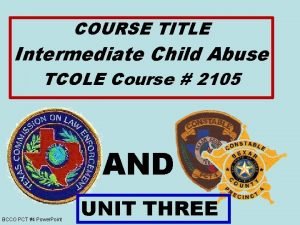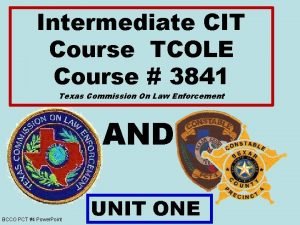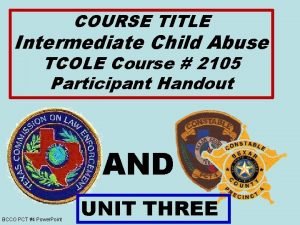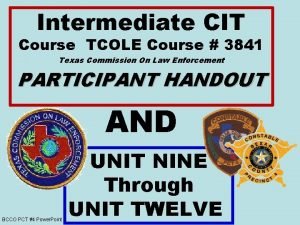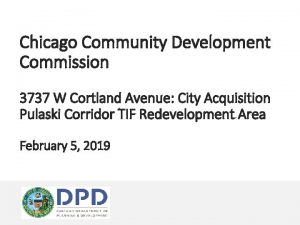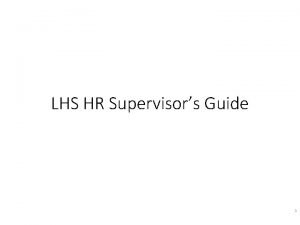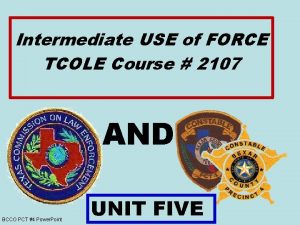Supervisors Leadership 24 hrs TCOLE Course 3737 AND





















































































- Slides: 85

Supervisors Leadership (24 hrs) TCOLE Course # 3737 AND BCCO PCT #4 Power. Point UNIT ONE

ADMINISTRATIVE • Please complete the BCCO PCT #4 Registration form and turn it in now. • Make sure you sign TCOLE Report of Training (PID#, Full Name and DOB). • All cell phones off please – pay attention to course materials and show common respect & courtesy.

Your Instructor – Course Facilitator and Mentor Trainer Deputy Chief George D. Little A. S. & B. S. Criminal Justice & Sociology B. S. CJ Wayland Baptist University, San Antonio M. S. Criminology & Counter-Terrorism University of the State of New York(P) 2012 T. C. O. L. E. Professional Achievement Award Certified Crime Prevention Specialist (C. C. P. S. ) FAMS TCOLE Basic Instructor Certificate 1984 CERTIFIED TCOLE Advanced Instructor 2012 INSTRUCTOR TCOLE Master Peace Officer 1991 MP Special Operations Operator Counter-Terrorism 1988, Military Police Investigations (MPI) & Criminal Investigation Division (CID) Special Agent & Joint Counter-Drug Operations Element HQ 5 A Graduate Drug Enforcement Administration Academy 1977 44 - years Law Enforcement Experience 40 -Years Teaching & Instructor Experience 12/5/2020 3

COURSE/LESSON OVERVIEW • • Legal Obligations and requirements Role Identification Values Ethics and principals Communication Leadership Styles Counseling Liability and Civil Rights Special Investigative Issues and More Refer to your participant handout

Learning Objectives Learning Objective 1. 0: Learning Objective 2. 0: Learning Objective 3. 0: Learning Objective 4. 0: Learning Objective 5. 0: Refer to your participant handout for each individual units learning objectives

Learning Objectives Learning Objective 6. 0: Learning Objective 7. 0: Learning Objective 8. 0: Learning Objective 9. 0: Learning Objective 10. 0:

Learning Objectives Learning Objective 11. 0: Learning Objective 12. 0: Learning Objective 13. 0: Learning Objective 14. 0: Learning Objective 15. 0:

FORWARD This course is designed to provide the participant with basic leadership knowledge and skills to be prepared as a new supervisor. This course meets the requirements for compliance with 1701. 352 Occupations Code for new supervisor training.

GOOD LEADERSHIP Good leadership involves responsibility to the welfare of the agency, which means that some people will get angry at your actions and decisions. It's inevitable, if you're honorable. Trying to get everyone to like you is a sign of mediocrity and not good leadership: “Leaders

GOOD LEADERSHIP Continued you'll avoid the tough decisions, you'll avoid confronting the people who need to be confronted, and you'll avoid offering differential rewards based on differential performance because some people might get upset.

GOOD LEADERSHIP - Continued Ironically, by procrastinating on the difficult choices, by trying not to get anyone mad, and by treating everyone equally "nicely" regardless of their contributions, you'll simply ensure that the only people you'll wind up angering are the most creative and productive people in your Powell on Leadership agency, Colin department or office

UNIT ONE Relevant Commission Rules and Legislative Changes

1. 0 Relevant Commission Rules and Legislative Changes for Supervisors Texas Occupation Code Refer to your participant handout

1. 1 Statutory Requirements of Chapter 1701 Texas Occupation Code A. 1701. 352 Continuing Education Programs B. 1701. 354 Continuing Education for Constables and Deputy Constables Refer to your participant handout

1. 1 Statutory Requirements of Chapter 1701 Texas Occupation Code – Continued C. 1701. 355 Continuing Demonstration of Weapons Proficiency Refer to your participant handout

1. 2 TCOLE Rules for officer reporting and for Continuing Education A. Reporting Responsibilities of Individuals § 211. 27 B. Responsibility of Agency Chief Administrators § 211. 29 Refer to your participant handout

1. 2 TCOLE Rules for officer reporting and for Continuing Education – Continued C. Legislatively Required Continuing Education for Licensees § 217. 11 D. Firearms Proficiency Requirements § 217. 21 Refer to your participant handout

1. 2 TCOLE Rules for officer reporting and for Continuing Education – Continued E. Reactivation of a Licenses § 217. 19 F. Law Enforcement Achievement Awards § 211. 33 Refer to your participant handout

1. 3 Legislative Changes Refer to your participant handout

Questions?

DEFINE & PROCESS Define 1. 0: Explain the Process: 21

1. 4 Define Leadership The art of influencing and directing subordinates in a manner as to obtain their willing obedience, confidence and respect towards achieving agency duties & responsibilities & accomplishing agency executive goals, objectives and mission

2. 1 Supervisor Leaders Role

2. 1 Supervisor/Leaders Role 1. Group #1 identifies management’s expectations. 2. Group #2 identifies the first-line supervisor’s concept of the role. 3. Group #3 identifies the subordinate’s expectation. 4. Each group spokesman shares results of group findings with class

2. 1. A. Supervisor/Leaders Role Management Expectations 1. Set the example 2. Shift from doing the work to getting it done through others Delegation 3. Support department policies and procedures Set the Standard 4. Stay cool under pressure

2. 1. A. Supervisor/Leaders Role Management Expectations -Cont’d 5. Don't be afraid to exercise supervisory rights 6. Develop subordinates 7. Look at the big picture

2. 1. A. Supervisor/Leaders Role Management Expectations -Cont’d 8. Protect welfare of subordinates a. Civil suits – diminished liability b. Injury/death c. Health d. Safety 9. Solve Problems

2. 1. B. Supervisor/Leaders Role Subordinate Expectations 1. Leader, controller, coordinator 2. Resource person, should possess a higher level of technical knowledge 3. Responsible for protecting employee rights

2. 1. B. Supervisor/Leaders Role Subordinate Expectations – Cont’d 4. Subordinates representative to management 5. Protect welfare a. Civil suits c. Health b. Injury/death d. Safety 6. Understand human failure and people problems

2. 1. C. Supervisor/Leaders First-Line Supervisor Role 1. Subordinates line to management, sometimes a buffer 2. Responsible for getting work done 3. Enforcer of department policies and procedures and/or SOP a. Evaluator/reporter/endorser Evaluator

2. 1. C. Supervisor/Leaders First. Line Supervisor Role – Cont’d 4. Expected to be an expert in law, policy, procedure, SOP and human dynamics 5. Expected to lead by example (role model, trainer & Mentor)

2. 1. D. Supervisor/Leaders Role External Expectations 1. Community 2. Media 3. City Government (mgr. ) 4. Cultural 5. Individual citizen

2. 1. E. Supervisor/Leaders Role Achieving Results 1. Inspection (Evaluating Performance) a. Quarterly ratings to ensure maximum professionalism is achieved. b. Annual performance appraisal c. Professional development of subordinates

2. 1. E. Supervisor/Leaders Role Achieving Results – Cont’d 2. Follow-up (Training in deficient areas and develop strengths). a. Traditionally, b. management has focused on weaknesses.

2. 1. E. Supervisor/Leaders Role Achieving Results – Cont’d 2. Follow-up (Training in deficient areas and develop strengths). Cont’d c. A good manager focuses on strengths and the development of them, while at the same time working on improving weaknesses.

2. 1. E. Supervisor/Leaders Role Achieving Results – Cont’d 3. How to talk to employees (Communications skills are critical) 4. Human relations skills (knowing your people)

2. 1. E. Supervisor/Leaders Role Achieving Results – Cont’d 5. Peer group relationships 6. Your relationships with your superiors

2. 1. F. Supervisor/Leaders Role Panel Discussion 1. Management's view presented by a law enforcement agency manager, preferably a chief or operations commander.

2. 1. F. Supervisor/Leaders Role Panel Discussion – Cont’d 2. The view of the middle manager should be presented by a lieutenant or equivalent who is responsible for supervision of the supervisor. ive.

2. 1. F. Supervisor/Leaders Role Panel Discussion – Cont’d 3. The view of the first-line supervisor should be presented by an veteran & experienced supervisor.

2. 1. F. Supervisor/Leaders Role Panel Discussion – Cont’d 4. The view of either a private sector or non-police public sector manager should present a view of management from their perspective.

2. 1. G. Supervisor/Leaders Competencies of Excellence 1. Achievement Orientation a. Goal orientation (1) Sets specific goals for self and/or work group (2) Seeks to exceed require/expected performance levels

2. 1. G. Supervisor/Leaders Competencies of Excellence – Cont’d 1. Achievement Orientation a. Goal orientation – Cont’d (3) Involves employees in setting performance goals

2. 1. G. Supervisor/Leaders Competencies of Excellence – Cont’d 1. Achievement Orientation b. Bottom-Line orientation (1) Seeks out areas where productivity and/or quality can be improved (2) Cites specific savings achieved in cost, time, and other resources

2. 1. G. Supervisor/Leaders Competencies of Excellence – Cont’d 1. Achievement Orientation b. Bottom-Line orientation (3) Encourages others to seek out areas where quality, productivity and/or costs can improve

2. 1. G. Supervisor/Leaders Competencies of Excellence – Cont’d 1. Achievement Orientation c. Communicates and enforces standards (1) Establishes clear requirements and performance standards.

2. 1. G. Supervisor/Leaders Competencies of Excellence – Cont’d 1. Achievement Orientation c. Communicates and enforces standards (2) Clarifies and explains the importance of given requirements and/or performance standards.

2. 1. G. Supervisor/Leaders Competencies of Excellence – Cont’d 1. Achievement Orientation c. Communicates and enforces standards (3) Develops and uses procedures to monitor employee adherence to requirements and/or standards.

2. 1. G. Supervisor/Leaders Competencies of Excellence – Cont’d 1. Achievement Orientation c. Communicates and enforces standards (4) Articulates consequences to employees for failing to meet or maintain requirements or standards.

2. 1. G. Supervisor/Leaders Competencies of Excellence – Cont’d 1. Achievement Orientation c. Communicates and enforces standards (5) Documents critical performance information.

2. 1. G. Supervisor/Leaders Competencies of Excellence – Cont’d 1. Achievement Orientation d. Initiative (1) Actively seeks opportunities to solve problems. (2) Improvises new solutions, systems, or procedures.

2. 1. G. Supervisor/Leaders Competencies of Excellence – Cont’d 1. Achievement Orientation d. Initiative (3) Takes on responsibilities beyond the day-to-day requirements of the job.

TAKE A 10 -MINUTE BREAK

2. 1. G. Supervisor/Leaders Competencies of Excellence – Cont’d 2. Skillful use of influence a. Strategic influence (1) Considers and/or employs strategies to influence others (e. g. , suggests alternatives, points out benefits, outlines details, intensely prepares).

2. 1. G. Supervisor/Leaders Competencies of Excellence – Cont’d 2. Skillful use of influence a. Strategic influence (2) Strongly states/asserts position in order to convince others.

2. 1. G. Supervisor/Leaders Competencies of Excellence – Cont’d 2. Skillful use of influence a. Strategic influence (3) Communicates the "big picture" or explains "why" when presenting to employees.

2. 1. G. Supervisor/Leaders Competencies of Excellence – Cont’d 2. Skillful use of influence a. Strategic influence (4) Forms alliances with key people to accomplish objectives.

2. 1. G. Supervisor/Leaders Competencies of Excellence – Cont’d 2. Skillful use of influence b. Communicates confidence in people (1) Expresses belief in others' capabilities and/or potential.

2. 1. G. Supervisor/Leaders Competencies of Excellence – Cont’d 2. Skillful use of influence b. Communicates confidence in people (2) Provides encouragement, and/or special attention to enhance others' confidence and/or capabilities.

2. 1. G. Supervisor/Leaders Competencies of Excellence – Cont’d 2. Skillful use of influence b. Communicates confidence in people (3) Takes risks based on belief/faith in employees. (4) Gives employees opportunities to try new things.

2. 1. G. Supervisor/Leaders Competencies of Excellence – Cont’d 2. Skillful use of influence c. Interpersonal sensitivity (1) Responds to others based on understanding of their point of view, interests and/or concerns.

2. 1. G. Supervisor/Leaders Competencies of Excellence – Cont’d 2. Skillful use of influence c. Interpersonal sensitivity (2) Observes, interprets, and takes action based on non-verbal cues.

2. 1. G. Supervisor/Leaders Competencies of Excellence – Cont’d 2. Skillful use of influence c. Interpersonal sensitivity (3) Uses knowledge of employees' interests, strengths, weaknesses, or aptitude when making assignments.

2. 1. G. Supervisor/Leaders Competencies of Excellence – Cont’d 2. Skillful use of influence c. Interpersonal sensitivity (4) Demonstrates concern for others'' personal interests and/or well-being.

2. 1. G. Supervisor/Leaders Competencies of Excellence – Cont’d 2. Skillful use of influence d. Develops and coaches others (1) Provides resources or support to better enable employees to accomplish tasks.

2. 1. G. Supervisor/Leaders Competencies of Excellence – Cont’d 2. Skillful use of influence d. Develops and coaches others (2) Gives others specific instruction about how to perform tasks.

2. 1. G. Supervisor/Leaders Competencies of Excellence – Cont’d 2. Skillful use of influence d. Develops and coaches others (3) Makes challenging assignments available to employees.

2. 1. G. Supervisor/Leaders Competencies of Excellence – Cont’d 2. Skillful use of influence e. Gives performance feedback (1) Rewards or otherwise acknowledges good performance or performance improvements.

2. 1. G. Supervisor/Leaders Competencies of Excellence – Cont’d 2. Skillful use of influence e. Gives performance feedback (2) Directly confronts employees about poor performance.

2. 1. G. Supervisor/Leaders Competencies of Excellence – Cont’d 2. Skillful use of influence e. Gives performance feedback (3) Consults or refers to documentation in order to give feedback to employees.

2. 1. G. Supervisor/Leaders Competencies of Excellence – Cont’d 2. Skillful use of influence f. Collaboration and team building (1) Involves others in decision making and responds to their inputs.

2. 1. G. Supervisor/Leaders Competencies of Excellence – Cont’d 2. Skillful use of influence f. Collaboration and team building (2) Promotes collaborative problem solving within and between work groups. (3) Keeps others informed.

2. 1. G. Supervisor/Leaders Competencies of Excellence – Cont’d 2. Skillful use of influence f. Collaboration and team building (4) Uses a variety of strategies to promote team unity and commitment (e. g. , sponsors parties, food spreads, visits from top management).

2. 1. G. Supervisor/Leaders Competencies of Excellence – Cont’d 3. Conceptual skills a. Systematic problem solving (1) Asks key questions gathers data to understand problem situations. .

2. 1. G. Supervisor/Leaders Competencies of Excellence – Cont’d 3. Conceptual skills – Cont’d a. Systematic problem solving (2) Anticipates likely consequences of different approaches to problems. (3) Draws conclusions based on objective data.

2. 1. G. Supervisor/Leaders Competencies of Excellence – Cont’d 4. Concern for image a. Image and reputation (1) Actively works to build and maintain credibility.

2. 1. G. Supervisor/Leaders Competencies of Excellence – Cont’d 4. Concern for image a. Image and reputation (2) Demonstrates concern for personal and/or work group image or reputation.

2. 1. G. Supervisor/Leaders Competencies of Excellence – Cont’d 4. Concern for image a. Image and reputation (3) Says or does things for a specific and desired impact on personal and/or work group reputation.

2. 1. G. Supervisor/Leaders Competencies of Excellence – Cont’d 4. Concern for image b. Self-confidence (1) Demonstrates confidence in own abilities and decisions (e. g. , will take action based on personal convictions even when others hold opposing views). .

2. 1. G. Supervisor/Leaders Competencies of Excellence – Cont’d 4. Concern for image b. Self-confidence (2) Displays a willingness to be held accountable. (3) Takes risks to achieve specific objectives.

Questions?

DEFINE & PROCESS Define 2. 0: Explain the Process: 82

SOURCES All Course Sources and/or Resources are listed in your Participant Handout First-Line Supervisor LEADERSHIP TCOLE Course # 3737 Bexar County Constable Office PCT#4

“Knowledge is “POWER” Stay informed, stay SAFE, stay Vigilant & stay Alive”

TAKE A 10 -MINUTE BREAK
 Tcole 3737
Tcole 3737 Tcole 3737
Tcole 3737 Tcole 3737
Tcole 3737 A day has hours
A day has hours Leader safety course module 2 answers
Leader safety course module 2 answers Basic instructor course #1014
Basic instructor course #1014 Basic instructor course texas
Basic instructor course texas Tcole advanced instructor course
Tcole advanced instructor course Tcole crime scene investigation
Tcole crime scene investigation Tcole 1014 basic instructor course
Tcole 1014 basic instructor course Tcole advanced instructor course
Tcole advanced instructor course Tcole advanced instructor course
Tcole advanced instructor course Tcole 2106 crime scene investigation
Tcole 2106 crime scene investigation Basic instructor course #1014
Basic instructor course #1014 Eeo training for managers
Eeo training for managers Eeo compliance training
Eeo compliance training Nh road cross section
Nh road cross section Speed tdst
Speed tdst Hrs types
Hrs types How to write hour
How to write hour Cdmvt navigation
Cdmvt navigation 1300 hrs
1300 hrs 1300 hrs
1300 hrs Resolve hrs
Resolve hrs Hrs rand
Hrs rand Hrs
Hrs Bitgain 24 hrs
Bitgain 24 hrs Hrs
Hrs Wake up 24 hrs
Wake up 24 hrs Eztable taiwan
Eztable taiwan Tdasc
Tdasc Ounces of ice cream in a large milkshake
Ounces of ice cream in a large milkshake Ergonomics awareness training for supervisors
Ergonomics awareness training for supervisors Ergonomics awareness training for supervisors
Ergonomics awareness training for supervisors Danger zones for supervisors
Danger zones for supervisors Trinity county board of supervisors meeting
Trinity county board of supervisors meeting Bath county board of supervisors
Bath county board of supervisors Pa association of township supervisors
Pa association of township supervisors Pa state association of township supervisors
Pa state association of township supervisors Gp supervisor requirements
Gp supervisor requirements Course title and course number
Course title and course number Transformational vs transformative leadership
Transformational vs transformative leadership Tcole 2106
Tcole 2106 Tcole cultural diversity answers
Tcole cultural diversity answers Tcole 2105
Tcole 2105 Tcole 2105
Tcole 2105 Ccp
Ccp Tcole cit
Tcole cit Tcole 2107
Tcole 2107 Tcole 2105
Tcole 2105 Tcole 2105
Tcole 2105 Tcole 4068
Tcole 4068 Tcole 3275
Tcole 3275 Tcole 2106
Tcole 2106 Intermediate crime scene investigation texas
Intermediate crime scene investigation texas Tcole 2105
Tcole 2105 T junction in english bond
T junction in english bond Course interne course externe
Course interne course externe Amy tishelman
Amy tishelman Adaptive leadership vs situational leadership
Adaptive leadership vs situational leadership Capable but cautious performer
Capable but cautious performer Module 7 weights and measurements
Module 7 weights and measurements Holder in due course
Holder in due course Reconnaissance and surveillance leaders course
Reconnaissance and surveillance leaders course Holder in due course example
Holder in due course example Which is a holder in due course?
Which is a holder in due course? Occupational health and safety course outline
Occupational health and safety course outline Ap world history course and exam description
Ap world history course and exam description Course 2 chapter 1 ratios and proportional reasoning
Course 2 chapter 1 ratios and proportional reasoning Parallel and distributed computing syllabus
Parallel and distributed computing syllabus Ptit safe driving and awareness course online
Ptit safe driving and awareness course online Occupational health and safety course outline
Occupational health and safety course outline Course 2 contemporary india and education
Course 2 contemporary india and education Course 2 contemporary india and education
Course 2 contemporary india and education Course 2 contemporary india and education
Course 2 contemporary india and education Content based syllabus example
Content based syllabus example Weathr today
Weathr today Temperate zone latitude
Temperate zone latitude Recruitment and selection course outline
Recruitment and selection course outline Hr plans and operations course
Hr plans and operations course Theories of human development
Theories of human development Fatigue and damage tolerance course
Fatigue and damage tolerance course A foundation course in human values and professional ethics
A foundation course in human values and professional ethics Understand quran and salah the easy way pdf
Understand quran and salah the easy way pdf Investment analysis and portfolio management course
Investment analysis and portfolio management course Ap language and composition crash course
Ap language and composition crash course
